Fiberglass vessels have surged in popularity over recent decades owing to their clear advantages over conventional construction materials. Initially introduced in the mid-20th century, fiberglass composite swiftly emerged as a practical substitute for boat hulls, courtesy of its advantageous characteristics.
Fiberglass is crafted from glass fibers embedded in a thermosetting plastic resin matrix, typically epoxy or polyester. Upon curing, this yields an exceedingly robust and weather-resistant substance that is both lightweight and exceptionally structurally sound. In contrast to wooden or metallic crafts, fiberglass boats exhibit reduced susceptibility to decay and demand less upkeep throughout their lifespan.
Beyond durability, the buoyancy characteristics of fiberglass also make it safer for boating. Its composite construction allows for anti-sinking features like reserved buoyancy tanks that prevent total submersion if water enters the hull. Additionally, fiberglass easily lends itself to complex, hydrodynamically efficient hull shapes for speed and performance.
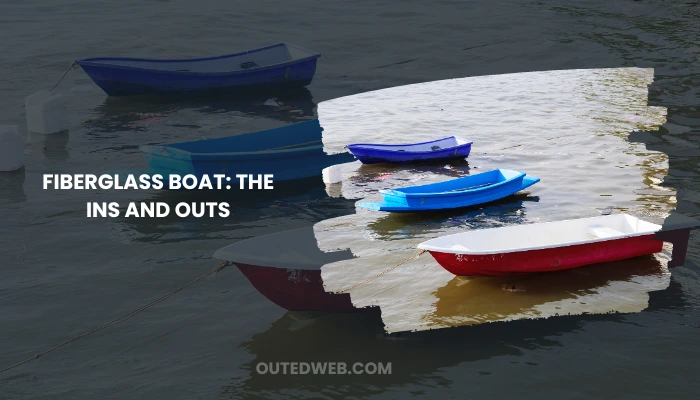
This guide will provide a comprehensive overview of fiberglass boats, including their:
- History and construction methods
- Strengths and key performance advantages
- Important design considerations
- Proper maintenance and upkeep techniques
- Costs and market varieties
By grasping the intricacies of fiberglass boats, you’ll be equipped to select, navigate, and maintain your vessel securely for numerous boating seasons ahead.
History and Construction Methods
If you’ve ever pondered the rise of fiberglass in modern boating, allow me to share an intriguing tale! Back in the 1930s and 40s, scientists delved into experimentation with novel composite materials—combinations of two or more substances melded together, akin to concrete.
They began blending glass fibers with plastics such as epoxy and polyester resin, birthing a remarkably robust yet lightweight material.
It wasn’t long before boat craftsmen recognized the remarkable potential of this “fiberglass.” In comparison to traditional wooden or metallic hulls, which are prone to decay and rust over time, fiberglass boasts unparalleled durability against the elements.
Word started spreading in boating communities about this “latest and greatest” material. Before they knew it, manufacturers were exploring all sorts of innovative hull designs that took advantage of fiberglass’ limitless shaping abilities.
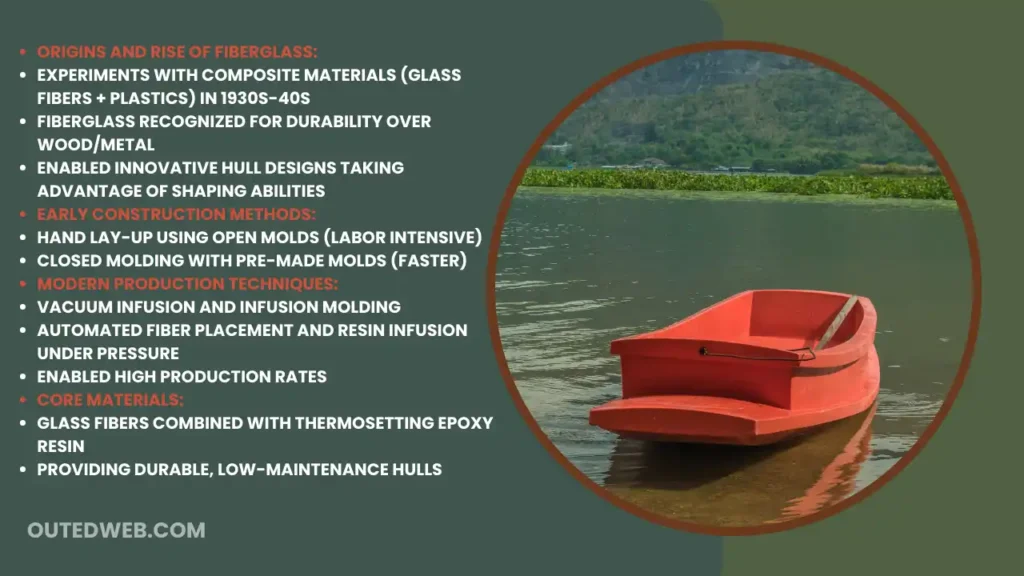
In the early days, most boats were hand-laid using the “open mold” method. Craftsmen would manually position individual glass fibers or mats painstakingly across open boat molds, wetting them with resin one layer at a time.
While it produced beautiful results, the process was extremely labor-intensive. By the 1960s, closed molding had emerged. Here, the layers were placed inside pre-made molds and rolled or brushed with resin, speeding things up significantly.
But the real revolution came with modern vacuum infusion and infusion molding. Now specialized machines intricately placed fibers exactly where needed before applying resin under pressure—talk about precision!
Entire boats could be cranked out faster than ever. It’s no wonder fiberglass utterly dominated boat production from then on. The advantages of long-lasting, low-maintenance vessels truly resonated with buyers.
While techniques evolved greatly, the core materials of glass fiber and thermosetting epoxy remains. Fiberglass continues carrying boaters of all kinds onto the waterways eagerly for fun and relaxation.
Strengths and Performance Characteristics
So we’ve covered the history of fiberglass boats and how they’re made. Now let me tell you why these puppies are so darn resilient—you’re not gonna believe all the perks of this magical material!
Durability is fiberglass’s middle name. The stuff is virtually unsinkable because it doesn’t rust, rot, or get waterlogged over time like wood. Fiberglass says “So long!” to degradation from the elements.
Need another reason why this stuff is bad? How about its insane strength-to-weight ratio – fiberglass is lighter than metal yet stronger than steel! That means boats can zip across the water without extra bulk slowing them down.
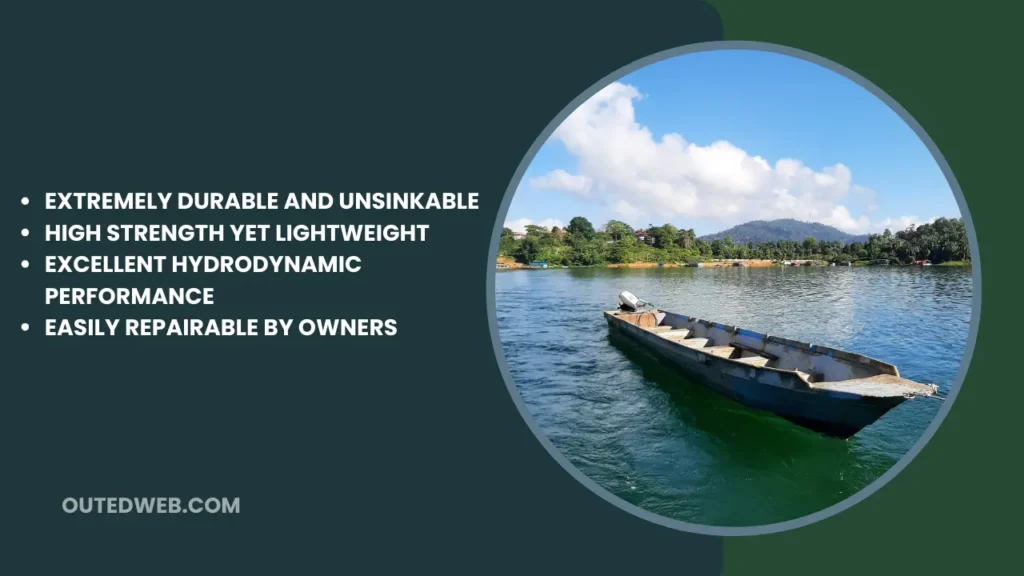
When it comes to hydrodynamics, fiberglass lets boat designers get creative. Its smooth surfaces create virtually no water resistance, so boats glide rather than fight the flow. And glass fibers are astonishingly flexible, allowing hulls to achieve incredible feats of aerodynamic perfection. Some racers made of this stuff can literally fly above the water!
Of course, fiberglass isn’t indestructible; that’s where repair comes in. Most dings and cracks can be fixed with nothing more than fiberglass cloth, resin, and elbow grease. Larger issues might require pressure lamination, but either way, a skilled owner can perform repairs themselves to save major bucks on the dock. With a little care, your boat’s fiberglass shell will feel just like new again.
Design Considerations
You know, an often overlooked part of any boat is its design. Sure, things like speed and storage space seem important, but without a well-crafted hull, even the swiftest vessel could find itself swamped! Fortunately for fiberglass devotees, these babies excel at more than just longevity.
Let’s start with hull shapes. Much like wind tunnel experiments reveal aerodynamic secrets, computational fluid dynamics now simulate water flow over virtual hulls. This aids designers in refining each curve and angle to slice through the surface efficiently. Get it just right and you’ve scored yourself a hydrodynamically smooth ride.
Beyond flow, hull form also influences other key traits. A flatter lower section provides greater stability at rest, while a lift near the bow handles waves with ease. Capacity stretches from the width of the beam. Calculating this volumetrics to float a given load without sacrificing speed – is a true naval engineering marvel.
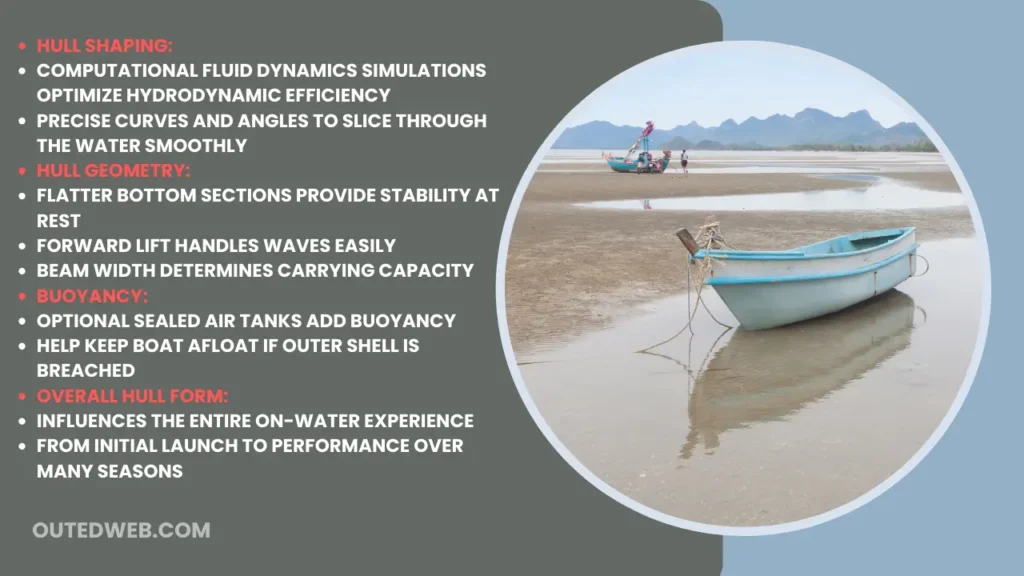
Of course, even the sturdiest hulled schooner must account for rare leakage. Fiberglass vessels up their buoyancy game with optional sealed tanks. Should cracks ever breach the outer shell, sealed air pockets help boats stay afloat until repairs commence. Talk about peace of mind!
So whether you favor paddling placid ponds or charging choppy coastlines, focus first on the hull. Its form will flavor your whole fiberglass experience, from initial shove-off to many seasons beyond. I hope these design details have you seeing shells in a new light—or, should I say, inspecting the keels of potential new rides? The water calls – the last one’s a rotten gummy worm!
Design Customization
Having the power to create your dream boat design, tailored to your exact specifications. That’s the beauty of fiberglass—it offers unparalleled flexibility and customization options!
Bend It Like Beckham (But With Fiberglass)
Fiberglass is like a sculptor’s clay, allowing you to mold and shape your vessel however you desire. Want a sleek, aerodynamic hull for speed? No problem! Would you prefer a roomier cabin for those cozy weekend getaways? Fiberglass has got your back. The possibilities are endless when it comes to hull designs, seating arrangements, and storage solutions.
Trend-Setting and Trail-Blazing
Speaking of possibilities, let’s talk about the hottest design trends in the fiberglass boat realm. Streamlined hulls for improved performance? Check. Ergonomic seating for ultimate comfort? Double-check. And don’t even get me started on the ingenious storage compartments that’ll make Marie Kondo proud.
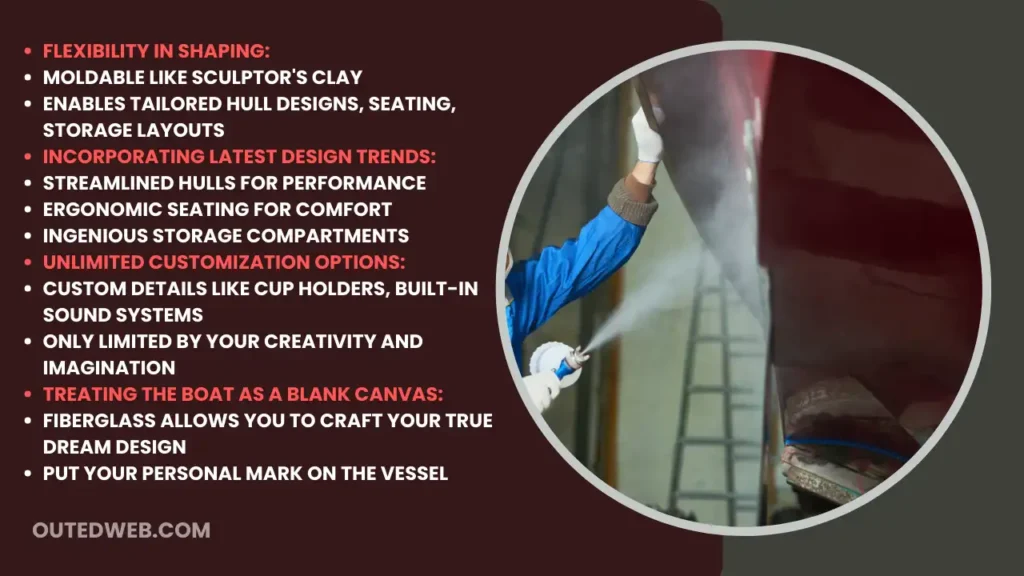
But why stop there? With fiberglass, you can truly let your creativity run wild. Customized cup holders for your favorite beverage? Done. A built-in sound system for those epic boat parties? Consider it installed!
The Sky’s the Limit (Well, the Water’s the Limit)
At the end of the day, fiberglass boats are like a blank canvas, waiting for you to unleash your inner Picasso. Customization is the name of the game, and with fiberglass, the only limit is your imagination. So, what are you waiting for? It’s time to start designing your dream boat and leaving your mark on the high seas!
Construction Process
Boats have been a fundamental part of human exploration and adventure for centuries, and the art of boat construction has evolved. The modern era has brought us the wonders of fiberglass boats, a true testament to human ingenuity and craftsmanship.
Materials of Fiberglass Boat Construction
At the heart of every fiberglass boat lies a harmonious blend of materials that work in symphony to create a masterpiece. As mentioned earlier, the primary components include:
Fiberglass reinforcement fabrics or mats, woven from strong and lightweight glass fibers, provide the backbone of the structure.
Polyester or vinylester resins act as binding agents that saturate and solidify the fiberglass layers, ensuring strength and durability.
Core materials, such as foam or balsa wood, are strategically placed within the laminate to add stiffness, insulation, and buoyancy.
Fiberglass Construction Techniques
Like a skilled artist wielding a brush, boat builders employ various techniques to shape and mold fiberglass into their desired forms. Two prominent methods stand out:
The Hand-Laid Approach
In this labor-intensive yet time-honored tradition, fiberglass reinforcements are meticulously positioned within a mold by skilled hands. The fiberglass layers are then saturated with catalyzed resin using rollers or brushes, creating a strong and seamless bond. This process requires patience, expertise, and a deep understanding of the materials’ properties.
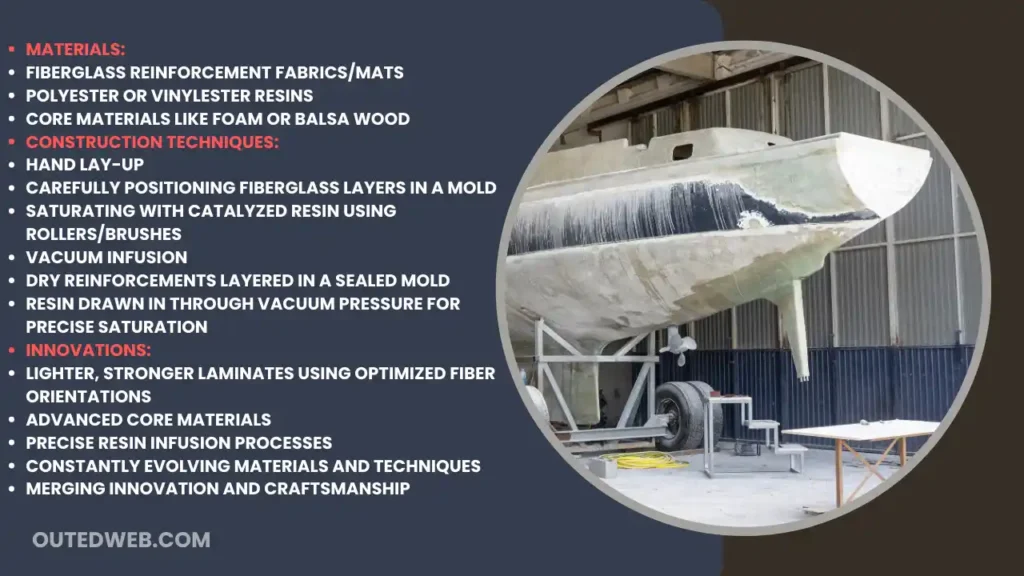
The Vacuum Infusion Mastery
A process where the resin is drawn into the reinforcement layers like a magnet, ensuring a precise and controlled saturation. This is the essence of vacuum infusion, a closed-mold technique that harnesses the power of vacuum pressure.
Dry reinforcements are layered within a mold, sealed with a vacuum bag, and the resin is drawn in through strategic inlet ports, resulting in a consistent and high-quality laminate with minimal emissions and excess resin.
Crafting the Future: Innovations in Fiberglass Boat Construction
Like any artistic pursuit, the world of fiberglass boat manufacturing is constantly evolving, embracing new materials and techniques to push the boundaries of performance, efficiency, and sustainability.
Modern production methods aim to create lighter and stronger hull laminates through the strategic use of optimized fiber orientations, advanced core materials, and precise resin infusion processes.
As we embark on new voyages, the future of fiberglass boat construction promises to be an exciting and ever-evolving journey, where innovation and craftsmanship merge to create vessels that not only defy the elements but capture the hearts and imaginations of adventurers and explorers alike.
Environmental Impact
As mentioned earlier, unlike the traditional wooden boats of yore, fiberglass boats offer a durable and low-maintenance alternative. But wait, there’s a catch! The manufacturing process involves the use of volatile organic compounds (VOCs) and other hazardous materials, leaving an environmental footprint that’s harder to sweep under the rug.
Fiberglass vs. Other Materials
When it comes to the operational lifetime of a vessel, fiberglass holds its own against the likes of wood and steel. Its resilience and minimal upkeep requirements make it a formidable contender in the race for sustainability. However, the real challenge lies in the end-of-life disposal of these composite marvels.
A Recycling Conundrum
Alas, the complex composition of fiberglass boats poses a daunting task for recyclers. As these obsolete vessels reach the end of their journey, they often find themselves abandoned or languishing in landfills, a fate unbecoming of their seafaring glory.
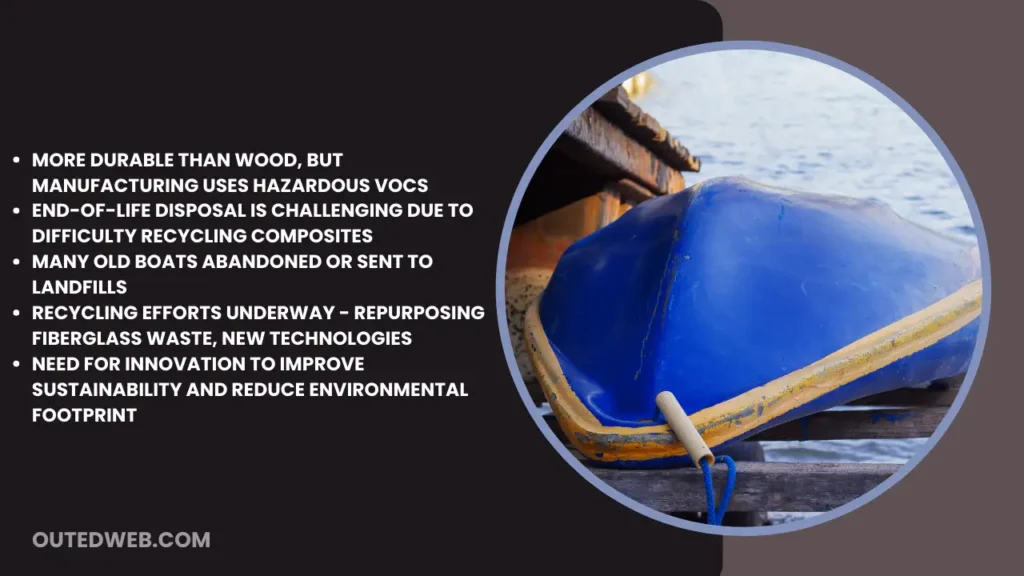
Innovative minds are hard at work, developing recycling technologies that could breathe new life into these discarded treasures. From mechanical and thermal processes to chemical wizardry, the quest for a sustainable solution is underway.
A Glimmer of Hope on the Horizon
Some ingenious approaches involve repurposing the fiberglass waste as structural materials or using it as a filler in new composite products. It’s like giving these retired vessels a chance to set sail once more but in a different form.
As we approach the end of our voyage, let us raise a glass to the uncharted waters that lie ahead. With determination and a steadfast commitment to sustainability, we can navigate the challenges of fiberglass boat manufacturing and chart a course towards a greener, more eco-friendly future.
Maintenance and Upkeep
You know, while fiberglass is renowned for its resilience, even superheroes require a bit of care now and then. Consistent buffing and polishing are essential to maintaining your boat’s radiant complexion for seasons to come.
A fiberglass skincare routine starts with a good scrub down. A mild detergent does the trick, rinsing away salt spray and algae buildup. Forgotten spots underneath may need elbow grease, so don’t forget to inspect fixtures too. Submerging any potential trouble spots in a bleach solution can sanitize surfaces and curb corrosion before problems escalate.
Protecting your boat’s complexion also means shielding it from the sun. Nothing zaps fiberglass’ youthful glow like UV exposure. Regular coats of a defensive wax deflect solar abuse, locking moisture out to prevent weathering. Look for ones touting UV resistance to get the most bang for your buck. A bi-annual application suits seasonal vessels.
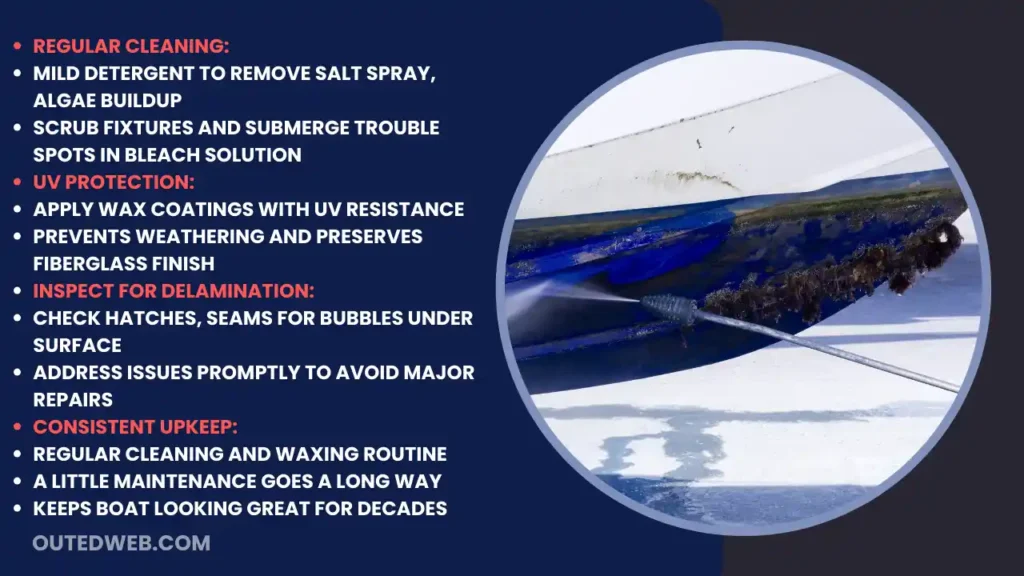
Of course, no prevention is full-proof. Over time, minor blemishes may emerge. Catching minor delamination early avoids major surgery down the line. Give the hatches and seams a poke to check for bubbles underneath. Addressing issues promptly means less time out of the water!
With diligence, your fiberglass vessel will stay looking fabulous for decades of adventures. Just be sure to show it the same care it shows you—a little maintenance goes a long way for long-lasting enjoyment! Now let’s get back out there before the day slips away!
Costs and Market Varieties
You know, deciding on a boat is a big investment, both upfront and down the line. Cost is definitely a key factor to ponder, but as any sailor knows, the true expense lies in ownership. Let me give you a quick play-by-play of what to budget for fiberglass boats.
New models naturally demand top dollar, with prices reflecting size, features, and intended use. Factor in several thousand at minimum for a basic powerboat or low five-figures for a no-frills daysailer. Custom rigging or electronics easily inflate costs. The used market offers deals if you’re handy with inspections. An experienced eye spots hidden issues.
Maintenance is where boat budgets face storms. Fiberglass shells stand the test of time, but other components demand care. Expect a few hundred annually just for preventative care like washings and waxing.
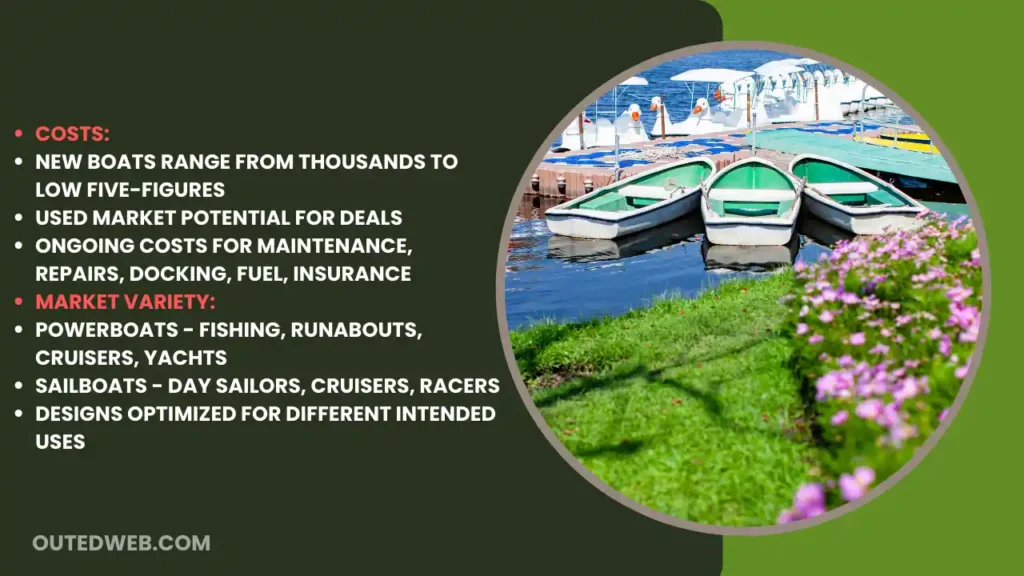
Replace worn through-hulls, hoses, and zinc to stem leaks before they become pricey repairs. Engine services lay out big bucks every couple of years. Docking and storage rack up additional costs depending on climate and storage style.
Factor in rising fuel costs too. Speed-loving powerboats slurp gas, so consider more frugal alternatives if long cruises are your thing. Sailboats tap the wind for free, offsetting fuel needs—but demand strong sailors! Insurance for liability and damage provides peace of mind at affordable premiums.
Buying Your Dream Fiberglass Boat
Buying a fiberglass boat is an exciting adventure, but it’s crucial to chart your course wisely. First, ponder your intended use – are you seeking thrills with watersports, a serene cruising experience, or perhaps some fishing escapades? This will guide you towards the perfect size for your vessel.
Speaking of size, don’t let budget constraints dampen your spirits! While fiberglass boats can be pricey, there are plenty of pre-loved gems waiting to be uncovered. But before you dive in, be sure to inspect for any blisters, gelcoat condition, and hull damage. A keen eye could save you from a sinking investment!

Where to Seek Your Bounty
Scour online marketplaces, attend boat shows, or visit local dealerships to scope out your options. Consult seasoned sailors and research reputable brands to ensure your new pride and delight are ship-shaped! And remember, a professional surveyor can be your trusted first mate in this nautical endeavor.
Popular Brands and Models
Constructed from weather-resistant fiberglass, these vessels are built to conquer the seas and deliver a comfortable, effortless journey. Buckle up as we explore some of the most celebrated brands and their exceptional models that have captured the hearts of boaters around the globe.
Fishing Fanatics
For those who live and breathe fishing, brands like Lund and Boston Whaler reign supreme. Lund’s Pro-V and Rebel models are practically angler royalty, designed with features that will make any fishing enthusiast swoon.
From ample storage to specialized hull designs, these boats were born to conquer the waters and reel in the big catch. On the other hand, Boston Whaler’s Outrage series is the epitome of offshore fishing prowess.
Cruising in Style
For those seeking a more leisurely on-water experience, Beneteau and Sea Ray have your backs (or, should we say, sterns?). Beneteau’s Oceanis series is the epitome of sailing elegance, combining performance and comfort in a sleek, fiberglass package.
But fear not, power-hungry boaters! Sea Ray’s Sundancer line offers the ultimate in cruising luxury. From plush interiors to powerful engines, these boats are designed to make every journey a first-class affair. Whether you’re embarking on a weekend getaway or an extended voyage, the Sundancer ensures you’ll travel in style.
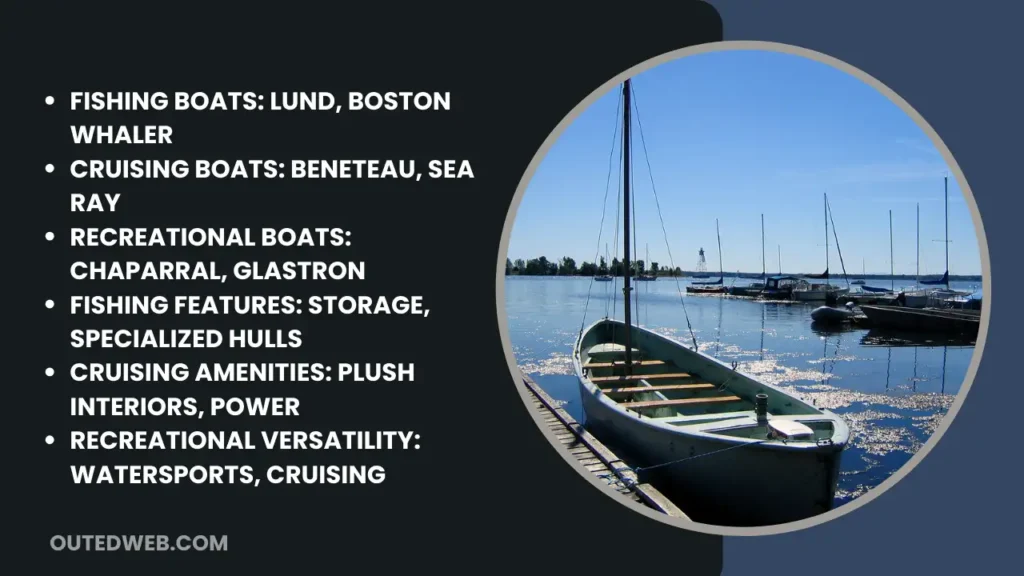
Recreational Revelry
If you’re a water-loving soul who craves versatility, brands like Chaparral and Glastron have got you covered. Chaparral’s Suncoast series is the jack-of-all-trades when it comes to fiberglass boats. Whether you’re seeking thrills with watersports or simply cruising along, these vessels are ready to deliver an unforgettable experience.
And let’s not forget Glastron’s GTD line of deck boats. These bad boys are the ultimate party hosts on the water, offering ample space for friends, family, and all the toys you can imagine. Crank up the tunes, fire up the grill, and let the good times roll—that’s the Glastron way!
Frequently Asked Questions
Alright, it’s question time! As any seasoned boater knows, fiberglass vessels often raise brows among newcomers. Let me try to answer some of the most common queries:
How Long Do Fiberglass Boats Typically Last?
With care, fiberglass hulls can go 30+ years before needing anything more than routine maintenance. Proper care is key; neglect shortens their lifespan.
What Are Some Signs of Deterioration or Damage?
Look for cracks, bubbles, or softened gelcoat edges. Faded, chalky hulls also indicate sun damage beneath. Minor issues caught early prevent costly repairs later.
How Does Fiberglass Boat Maintenance Differ by Climate?
Absolutely. Boats in salty or sunny environments require more care to combat corrosion and fading. Northern boats need additional winterizing against freezing. Tailor care to your region’s conditions.
What Boat Repairs Require Professional Help?
Major structural defects, laminate cracks, or rebuilding entire sections are jobs for competent marine repair shops. Otherwise, DIY small issues yourself to stay boat-savvy.
How Do You Select the Right Size And Type of Fiberglass Boat?
Consider family size, intended uses, trailer ability, and budget—don’t over- or under-boat. Experts can advise on a vessel matching your lifestyle.
How Can You Maximize a Fiberglass Boat’s Resale Value?
Keep records of upgrades, repairs, and equipment. Address issues immediately to avoid steeper discounts later. Maintain a pristine presentation inside and out.
What Precautions Should Be Taken for the Winter Storage of a Fiberglass Boat?
Thoroughly flush systems before layup. Remove batteries for care over the winter. Store indoors if possible on stands, covered to prevent damage from pests, dripping, and frost heaving.
Final Verdict
As you can see, with the proper understanding and routine care, a fiberglass vessel makes for an excellent long-term boating investment. Though an initial outlay is required, the durable and low-maintenance qualities of this material provide countless hours of enjoyable recreation for years down the line.
I hope sharing these insights helps you make the most of the boating adventures to come. Select a fiberglass vessel that meets your requirements, care for it diligently, and I’m certain it will provide you with numerous memorable days basking in the sun on the water. Tight lines and fair winds—may the breeze forever be in your favor!

